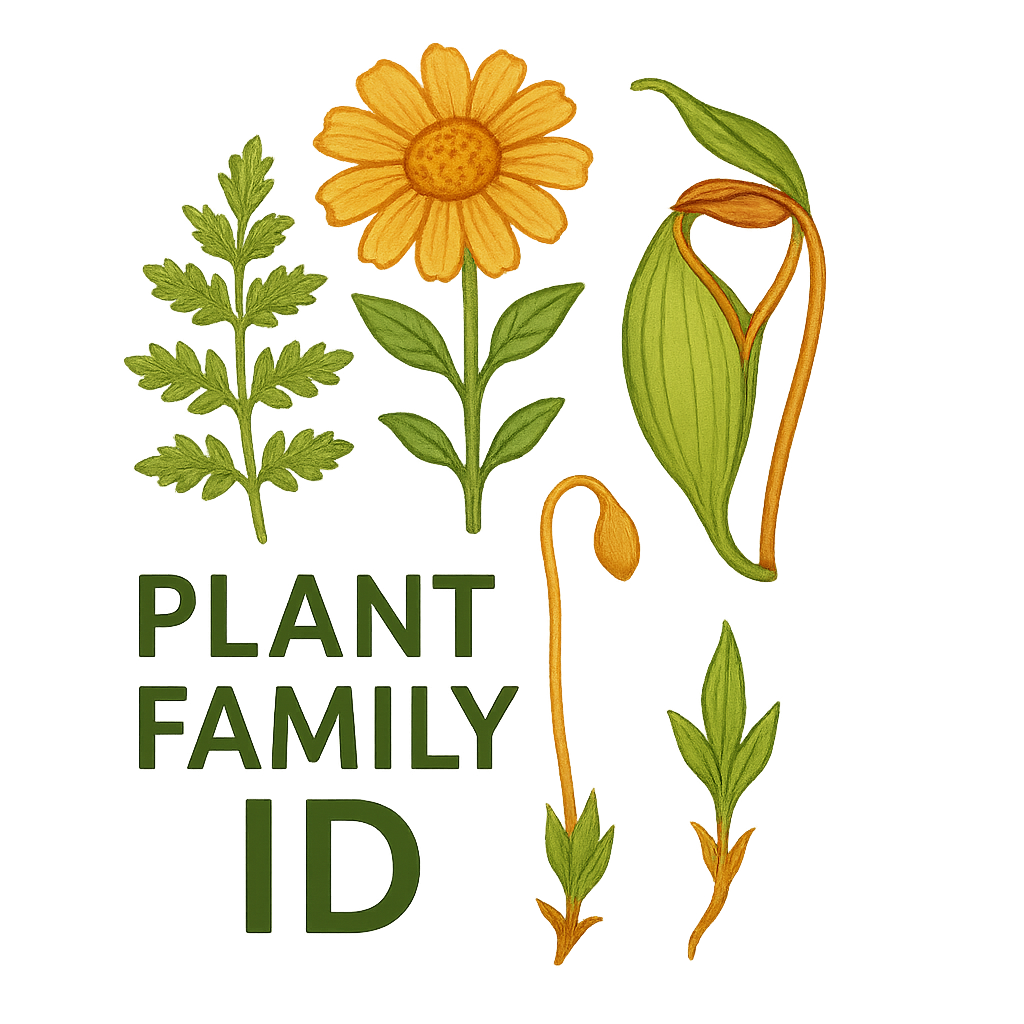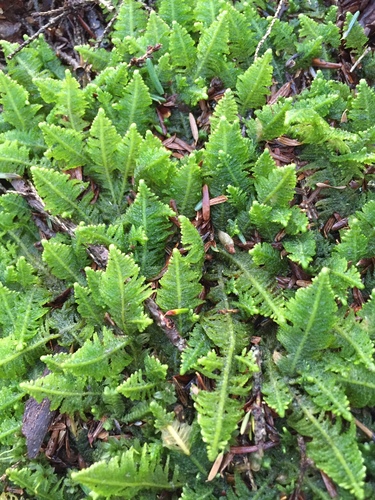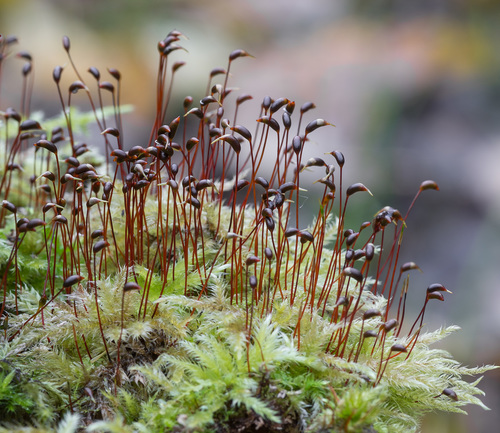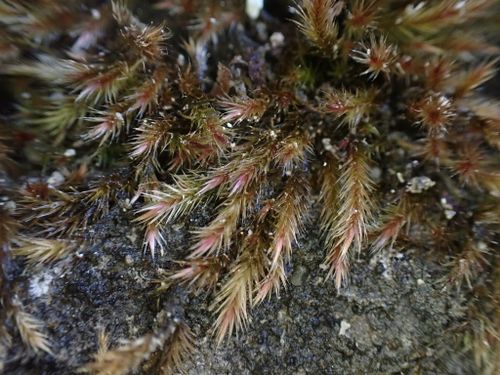Sematophyllaceae
Signal Moss Family
The Sematophyllaceae is a large family of pleurocarpous mosses, predominantly found in tropical and subtropical regions. They often form glossy mats or wefts, typically as epiphytes or on rocks. Key identifying features include leaves that are often falcate-secund, a costa that is very short and double or absent, and characteristically large, inflated alar cells at the leaf bases.
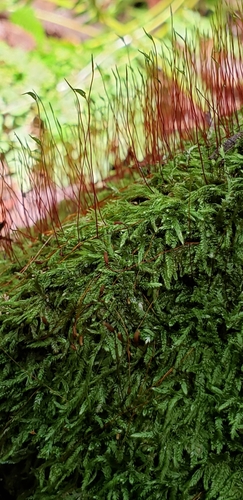
Overview
Sematophyllaceae is a major family within the order Hypnales, containing a large number of genera and species, especially diverse in the world's tropical and subtropical zones, although some members extend into temperate areas. These mosses are typically pleurocarpous, growing in spreading mats or intricate wefts, often exhibiting a characteristic glossiness, especially when dry.
They are commonly found as epiphytes on tree trunks, branches, twigs, and decaying logs, or growing on rocks (epilithic) in humid forest environments. Identification relies heavily on microscopic leaf characters, particularly the very short or absent costa and the prominently differentiated alar cells (large, inflated cells at the basal corners of the leaves). The leaves themselves are often curved (falcate-secund).
Quick Facts
- Scientific Name: Sematophyllaceae Broth.
- Common Name: Signal Moss Family (tentative, not widely used)
- Number of Genera: Approximately 40-50 (e.g., Sematophyllum, Brotherella, Acroporium, Trichosteleum, Wijkia)
- Number of Species: Approximately 400-600
- Distribution: Pantropical and subtropical, extending into temperate regions worldwide.
- Evolutionary Group: Bryophytes - Mosses (Class: Bryopsida, Order: Hypnales)
Key Characteristics
Growth Form and Habit
Plants are pleurocarpous, typically forming mats or wefts that are often glossy, especially when dry, frequently yellowish-green or golden-green. Stems are creeping, ascending, or sometimes pendent, usually irregularly to subpinnately branched.
Leaves
Leaves are frequently falcate-secund (sickle-shaped and curved to one side) or at least homomallous (all pointing in the same general direction), though sometimes straight or erect-spreading. Leaf shape is commonly lanceolate to ovate-lanceolate, usually tapering to a narrow point (acuminate). Margins are often serrulate (finely toothed) towards the apex, or sometimes entire. The costa (midrib) is characteristically very short and double, or often completely absent. A key diagnostic feature lies in the alar cells: the cells at the basal corners of the leaves are typically strongly differentiated, forming distinct groups. These alar cells are usually large, inflated, thin-walled, often oval or rectangular in shape, and sometimes colored yellowish or brownish. They may form distinct auricles (ear-like lobes) at the base. Upper leaf cells (laminal cells) are usually linear, rhomboidal, or fusiform (spindle-shaped), typically smooth (lacking papillae), though sometimes prorate (with cell ends projecting slightly).
Sporophyte (Capsule)
Sporophytes arise laterally from stems or branches. The seta (stalk) is usually long, slender or sometimes stout, often reddish, and can be smooth or papillose depending on the genus/species. The capsule is typically small, ovoid to short-cylindrical, often inclined to horizontal, and frequently constricted below the mouth when dry (strumose). Some species have erect capsules. The operculum (lid) is usually conical to long-rostrate (beaked).
The peristome is double and typically well-developed, of the Hypnoid type. The 16 outer exostome teeth are lanceolate, yellowish to brownish, often with a distinct zigzag median line, cross-striate below and papillose above. The inner endostome usually has a high basal membrane, keeled and often perforated segments, and typically well-developed cilia (usually in groups of 1-3).
Habitat
Primarily found as epiphytes growing on tree trunks, branches, twigs, prop roots, and decaying logs in humid forests. Also common as epiliths on shaded rocks. They are less frequently found growing directly on soil or humus. The family reaches its greatest diversity in tropical and subtropical regions.
Field Identification
Identifying Sematophyllaceae often requires close examination of leaf details, especially the costa and alar cells:
Primary Identification Features
- Costa Very Short & Double, or Absent: This is a key feature distinguishing them from many other pleurocarps (requires lens).
- Prominently Differentiated Alar Cells: Large, inflated, often colored cells forming distinct groups at the leaf base corners (best seen with magnification).
- Pleurocarpous Habit, Often Glossy: Forming mats or wefts, frequently with a yellowish or golden sheen.
- Habitat/Distribution: Primarily epiphytic or epilithic in tropical and subtropical forests.
- Falcate-Secund Leaves: Leaves often curved to one side (common but not universal).
Secondary Identification Features
- Smooth, Often Linear/Rhomboidal Leaf Cells: Upper leaf cells typically lack papillae.
- Small, Often Inclined/Strumose Capsule: Characteristic sporophyte shape and posture.
- Long Seta: Capsule usually held on a long stalk.
- Hypnoid Peristome: Well-developed double peristome (microscopic).
Seasonal Identification Tips
- Year-Round Gametophytes: Vegetative plants are present year-round in their typically humid habitats.
- Sporophytes Often Present: Many species fruit readily, and sporophytes can often be found throughout the year in tropical/subtropical regions.
Common Confusion Points
- Hypnaceae: Very similar family, also pleurocarpous, often glossy with falcate leaves and short/double costa. Distinction often relies on alar cells: Hypnaceae typically have smaller, more quadrate alar cells forming less conspicuously inflated groups compared to the large, inflated cells of Sematophyllaceae.
- Brachytheciaceae: Often have plicate (pleated) leaves and usually a distinct single costa extending further up the leaf. Alar cells are different.
- Plagiotheciaceae: Often have flattened (complanate) shoots and asymmetric leaves. Alar cells are usually poorly differentiated or decurrent (running down the stem). Costa short/double or absent.
- Entodontaceae: Often very glossy, complanate or julaceous (worm-like) shoots, leaves often symmetric with short/double costa, but alar cells usually indistinct and peristome structure differs (endostome segments often narrow or rudimentary).
Field Guide Quick Reference
Look For:
- Pleurocarpous mats, often glossy
- Habitat: Epiphytic/epilithic (Tropics/Subtropics mainly)
- Costa very short & double, or absent
- Alar cells large, inflated, distinct group
- Leaves often falcate-secund
Key Variations:
- Genera Sematophyllum, Brotherella, Acroporium etc.
- Leaf cells smooth, linear/rhomboidal
- Capsule small, often inclined/strumose
- Peristome double (Hypnoid)
Notable Examples
This is a large family with many genera, particularly diverse in the tropics.

Sematophyllum adnatum
Adnate Signal Moss
A common species in eastern North America, often found forming thin, appressed, glossy yellow-green mats on tree bases, logs, or rocks. Leaves are small, ovate-lanceolate, often slightly curved, with characteristic large, inflated alar cells. Costa is absent. Sporophytes are common, with reddish setae and small, inclined capsules.

Brotherella tenuirostris
Thin-beaked Brotherella Moss
Another species found in eastern North America and East Asia, typically on logs or tree bases in humid forests. Forms dense, glossy, often golden-green mats. Leaves are strongly falcate-secund with long, tapering points. Alar cells are large and inflated. Capsules are inclined on long reddish setae and have a long-beaked operculum.

Acroporium diminutum
(No common name widely used)
A representative of a large tropical genus, found in Southeast Asia, Australasia, and the Pacific. Often grows as an epiphyte. Plants form glossy mats. Leaves are typically lanceolate, acuminate, and often straight or only slightly curved. The genus is characterized by its usually erect capsules and specific alar cell patterns.
Phylogeny and Classification
Sematophyllaceae is a large and diverse family firmly placed within the order Hypnales, the largest order of mosses. It belongs to the core Hypnales lineage, often considered closely related to families like Hypnaceae, Brachytheciaceae, and Entodontaceae.
The family represents a major evolutionary radiation of pleurocarpous mosses, particularly successful in tropical epiphytic niches. Defining the boundaries between Sematophyllaceae and Hypnaceae can sometimes be challenging, relying on subtle differences in alar cell structure and peristome details. Molecular studies are continually refining the understanding of generic relationships within this large family and its placement within the Hypnales.
Position in Plant Phylogeny
- Kingdom: Plantae
- Division: Bryophyta (Mosses)
- Class: Bryopsida
- Order: Hypnales
- Family: Sematophyllaceae
Evolutionary Significance
The Sematophyllaceae family is significant for:
- Tropical Pleurocarp Diversity: Representing a major component of moss diversity in tropical and subtropical ecosystems, especially in epiphytic communities.
- Alar Cell Evolution: Showcasing the prominent development of large, inflated alar cells, a feature important in taxonomy and potentially related to water relations or leaf movement.
- Costa Reduction: Exhibiting a strong trend towards reduction or loss of the costa, common in many advanced pleurocarpous lineages.
- Hypnales Phylogeny: Providing crucial data points for understanding the complex evolutionary relationships within the massive Hypnales order.
